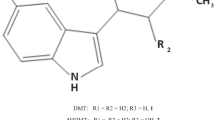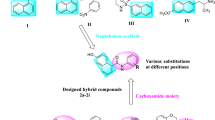Summary
The pyridine compounds nicotinamide, isonicotinamide, isonicotinic acid, isonicotinic acid hydrazide, 2-acetylpyridine, 4-acetylpyridine and 6-aminonicotinamide prolong the hexobarbital sleeping time. Nicotinic acid-N,N-dietylamide is without effect. The action of substances substituted at the position 4 of the pyridine ring is of only short duration. The sleep prolonging effect of 6-aminonicotinamide is elicited only after a latency of several hours.
The findings, under 4-acetylpyridine treatment, that no change in the barbital sleeping time occurs, that after hexobarbital the serum concentration of hexobarbital is greater than in normal animals and that the activity of the enzymes catabolising hexobarbital in the liver microsomes is diminished, suggest that 4-acetylpyridine and probably the other 4-substituted pyridine compounds act as inhibitors of the drug catabolising enzymes. 6-Aminonicotinamide prolongs the hexobarbital—as well as the barbital-sleeping time; it does not increase the hexobarbital serum concentration and does not diminish the activity of the microsomal enzymes. This antimetabolite of nicotinamide behaves, in many ways, similarly to the neuroleptic phenothiazines and reserpine. After application of 6-aminonicotinamide we elicited, in addition to the sleep prolonging effect, hypothermia, diarrhea and an increase of the corticosterone serum content. Moreover, we could show that phenothiazines diminish the activity of glucose-6-phosphate dehydrogenase, as does 6-aminonicotinamide which is converted in vivo to the physiologically inactive pyridine nucleotide 6-ANADP. The sleep prolonging effect of the 6-aminonicotinamide as well as of the neuroleptic drugs could therefore be due to a disturbance of the CNS pentose-phosphate cycle.
Zusammenfassung
Die Pyridinverbindungen Nicotinsäureamid, Isonicotinsäureamid, Isonicotinsäure, Isonicotinsäurehydrazid, 2-Acetylpyridin, 4-Acetylpyridin sowie 6-Aminonicotinsäureamid verlängern eine Hexobarbitalnarkose. Nicotinsäurediäthylamid ist unwirksam. Die an der Position 4 des Pyridinringes substituierten Substanzen wirken nur relativ kurz, während der narkoseverlängernde Effekt des 6-Aminonicotinamids erst nach einer Latenzzeit von mehreren Stunden nachweisbar wird.
Da unter 4-Acetylpyridin die Dauer einer Barbitalnarkose nicht verändert wird, die Hexobarbitalkonzentration im Serum erhöht ist und die Aktivität der das Hexobarbital abbauenden Fermente in den Lebermikrosomen vermindert ist, werden 4-Acetylpyridin und wahrscheinlich auch die anderen 4-substituierten Pyridinverbindungen als Hemmstoffe der arzneimittelabbauenden Enzyme wirksam. 6-Aminonicotinsäureamid verlängert sowohl die Hexobarbital- als auch die Barbitalnarkose, erhöht nicht die Hexobarbitalkonzentration im Serum und vermindert auch nicht die Aktivität der Mikrosomenfermente. Dieser Antimetabolit des Nicotinsäureamid verhält sich in vieler Beziehung wie neuroleptisch wirkende Phenothiazine und Reserpin. Neben der schlafverlängernden Wirkung kommt es nach Einwirkung von 6-Aminonicotinsäureamid zu einer Hypothermie, zu Diarrhoen und zu einem Anstieg des Corticosterongehaltes im Serum. Darüber hinaus konnte gezeigt werden, daß die Phenothiazine ähnlich wie 6-Aminonicotinsäureamid in Form des im Organismus gebildeten physiologisch nicht vorkommenden Pyridinnucleotids 6-ANADP die Aktivität der Glucose-6-Phosphat-Dehydrogenase vermindern. Der narkoseverlängernde Effekt des 6-Aminonicotinsäureamids wie auch der Neuroleptica könnte daher durch eine Störung im Pentosephosphatcyclus des ZNS zustande kommen.
Similar content being viewed by others
Abbreviations
- NAD:
-
Nicotinamid-adenin-dinucleotid
- NADP:
-
Nicotinamid-adenin-dinucleotid-phosphat
- NADPH2 :
-
Nicotinamid-adenin-dinucleotid-phosphat, red.
- NSA:
-
Nicotinsäureamid
- INS:
-
Isonicotinsäure
- INA:
-
Isonicotinsäureamid
- INH:
-
Isonicotinsäurehydrazid
- 2-AP:
-
2-Acetylpyridin
- 4-AP:
-
4-Acetylpyridin
- 6-AN:
-
6-Aminonicotinamid
- 6-ANADP:
-
6-Aminonicotinamid-adenin-dinucleotid-phosphat = Analoges des NADP
- CFT 1201:
-
Phenyldiallylessigsäuresster des Diäthylaminoäthanols
Literatur
Brodie, B. B., J. J. Burns, L. C. Mark, P. A. Lief, E. Bernstein, and E. M. Papper: Fat of pentobarbital in man, dog and a method of its estimation. J. Pharmacol. exp. Ther. 109, 26 (1953).
Brunnemann, A., H. Coper u. H. Herken: Isolierung von 3-Acetylpyridinadenin-dinucleotid (3-APAD) aus dem Gehirn 3-Acetylpyridin vergifteter Ratten. Naunyn-Schmiedebergs Arch. exp. Path. Pharmak. 244, 223 (1962).
—— —— —— Biosynthese von 3-Acetylpyridinadenindinucleotidphosphat (3-APADP) aus Nicotinamid-adenindinucleotidphosphat (NADP). Naunyn-Schmiedebergs Arch. exp. Path. Pharmak. 245, 541 (1963).
—— —— u. D. Neubert: Biosynthese und Wirkung des 6-Aminonicotinamidadenindinucleotids (6-ANAD). Naunyn-Schmiedebergs Arch. exp. Path. Pharmak. 246, 437 (1964).
Burton, R. M., R. A. Salvador, A. Goldin, and R. Humphreys: Interaction of nicotinamide with reserpine and chlorpromazine (II). Arch. int. Pharmacodyn. 128, 253 (1960).
Cook, L., J. J. Toner, and E. J. Fellows: The effect of SKF 525 A on hexobarbital. J. Pharmacol. exp. Ther. 111, 131 (1954).
Coper, H.: Stoffwechselstörungen durch Antimetaboliten des Nicotinamids aus: v. Kress u. Blum: B-Vitamine, Klinische und physiologisch chemische Probleme, S. 275–291. Stuttgart: F. K. Schattauer 1966.
Coper, H. Hadass u. H. Lison: Untersuchungen zum Mechanismus zentralnervöser Funktionsstörungen durch 6-Aminonicotinamid. Naunyn-Schmiedebergs Arch. Pharmak. exp. Path. 255, 97 (1966).
——, u. D. Neubert: Einfluß von NADP-Analogen auf die Reaktionsgeschwindigkeit einiger NADP-bedürftiger Oxydoreductasen. Biochim. biophys. Acta (Amst.) 89, 23 (1964).
Neubert, D., u. H. Coper: Die Geschwindigkeit der „malic enzyme“-Reaktion in Gegenwart von NADP-Analoga. Biochem. Z. 341, 485 (1965).
——, u. H. Herken: Wirkungssteigerung von Schlafmitteln durch den Phenyldiallylessigsäureester des Diäthylaminoäthanols. Naunyn-Schmiedebergs Arch. exp. Path. Pharmak. 225, 453 (1955).
Remmer, H.: Geschlechtsspezifische Unterschiede in der Entgiftung von Evipan und Thiopental bei Ratten. Naunyn-Schmiedebergs Arch. exp. Path. Pharmak. 233, 173 (1958).
—— Der beschleunigte Abbau von Pharmaka in den Lebermikrosomen unter Einfluß von Luminal. Naunyn-Schmiedebergs Arch. exp. Path. Pharmak. 235, 279 (1959).
Rutter, W. J., and H. A. Lardy: Purification and properties of pigeon liver malic enzyme. J. biol. Chem. 233, 374 (1958).
Silber, R. H., and C. C. Porter: The determination of 17,21-dihydroxy-20-ketosteroids in urine and plasma. J. biol. Chem. 210, 923 (1954).
Sweat, M. L.: Sulfuric acid induced fluorescence of cortico steroids. Analyt. Chem. 26, I 773 (1954).
Winter, Ch. A., and L. Flataker: The effect of cortisone, desoxycorticosterone, adrenocorticotrophic hormone and diphenylhydramine upon the responses of albino mice to general anaesthetics. J. Pharmacol. exp. Ther. 105, 358 (1952).
Zenker, N., and D. E. Bernstein: The estimation of small amounts of corticosterone in rat plasma. J. biol. Chem. 231, 695 (1958).
Author information
Authors and Affiliations
Rights and permissions
About this article
Cite this article
Coper, H., Deyhle, G., v. Herrath, D. et al. Zum Mechanismus der schlafverlängernden Wirkung verschiedener Pharmaka. Naunyn-Schmiedebergs Arch. Pharmak. u. Exp. Path. 260, 366–378 (1968). https://doi.org/10.1007/BF00537640
Received:
Issue Date:
DOI: https://doi.org/10.1007/BF00537640
Key-Words
- Sleep Prolonging Effect
- 4-acetylpyridine
- Inhibitor of Microsonal Enzymes
- 6-Aminonicotinamide
- Neuroleptic Like




